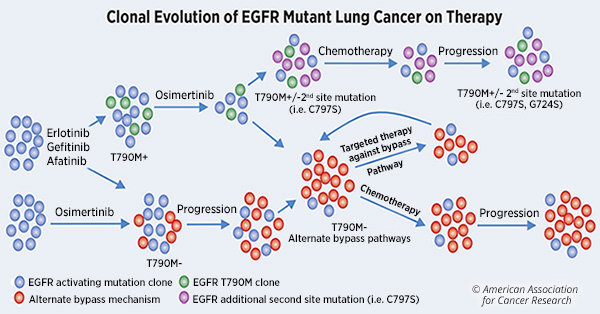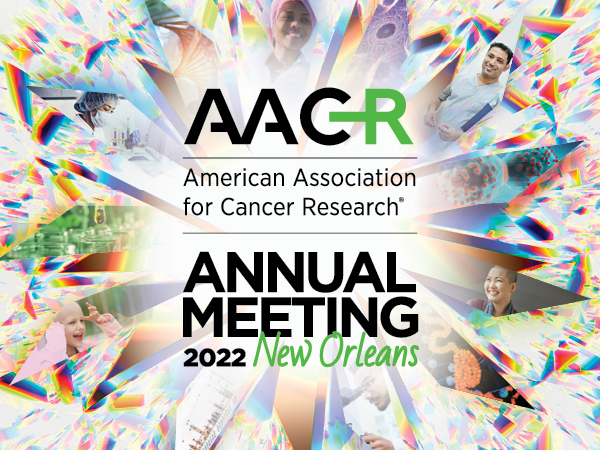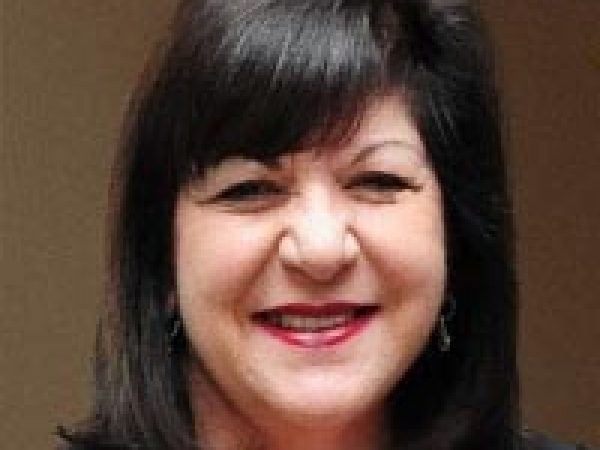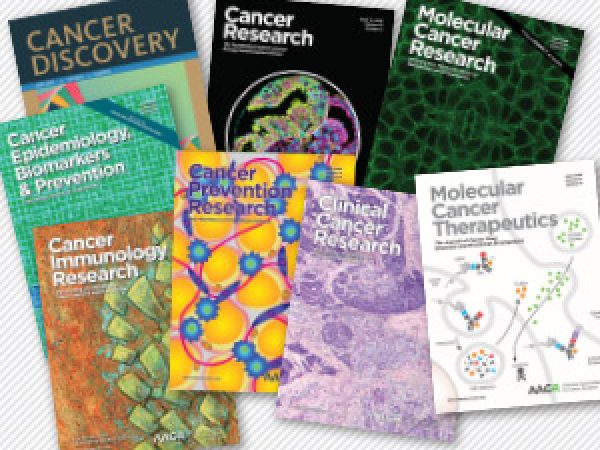AACR Annual Meeting 2019: New Approaches to Treating Drug-resistant Non-small Cell Lung Cancer
About 80 percent of lung cancers are non-small cell lung cancers (NSCLC), and about 15 to 20 percent of NSCLCs harbor epidermal growth factor receptor (EGFR)-activating mutations.
Treatment for EGFR-mutant NSCLC improved dramatically with the introduction of EGFR tyrosine kinase inhibitors (TKIs). Several TKIs targeting this receptor have been developed, including the U.S. Food and Drug Administration (FDA)-approved first-generation EGFR TKIs gefitinib (Iressa) and erlotinib (Tarceva); second-generation EGFR TKIs, such as the FDA-approved afatinib (Gilotrif) and dacomitinib (Vizimpro), and the investigational therapeutic neratinib; and third-generation EGFR TKIs, including the FDA-approved osimertinib (Tagrisso), and the investigational therapeutics olmutinib and nazartinib.
Even though patients with EGFR-mutated NSCLC experience substantial benefit from EGFR TKIs, their disease tends to progress within a year because the tumors ultimately develop resistance to the therapeutics. The most frequent activating EGFR mutations in NSCLC include the exon 19 deletion and L858R. Patients whose tumors harbor these activating EGFR mutations are treated with first-generation EGFR TKIs. While most patients initially respond to these therapeutics, more than 60 percent of them develop resistance by acquiring the “gatekeeper” point mutation, T790M. Third-generation inhibitors, such as osimertinib, were developed to target the T790M clone and to be active against the original exon 19 deletion and L858R. Patients, however, develop resistance to this treatment as well, through alternate bypass mechanisms, as described in this chart below.
A clinical trial plenary session titled “Can the Challenge of NSCLC Resistance Be MET or Will We Not MEK It?,” was held Sunday, March 31, at the AACR Annual Meeting 2019.
“To date, targeted therapy for lung cancer patients with EGFR mutations has consisted solely of monotherapy with various EGFR tyrosine kinase inhibitors, though we have known for more than 10 years that a proportion of resistance to EGFR TKIs results from activation of the MET bypass pathway,” said presenter Lecia V. Sequist, MD, MPH, from Massachusetts General Hospital Cancer Center, in a press release.
Acquired resistance through MET amplification as a bypass pathway is observed in about 5 to 10 percent of patients whose disease progresses after treatment with first- or second-generation EGFR TKIs and in about 25 percent of those whose disease progresses after treatment with third-generation EGFR TKIs. MET-driven resistance imparts a more aggressive behavior in EGFR-mutant cancers, Sequist noted.
Sequist presented data from two expansion cohorts of the phase Ib clinical trial TATTON.
Combining osimertinib with savolitinib
In the first cohort, a combination of osimertinib and the investigative MET inhibitor savolitinib was tested in patients with EGFR-mutant lung cancer with acquired resistance driven by MET amplification after treatment with a first- or second-generation EGFR TKI; the patients’ tumors were also negative for T790M mutation. In the second cohort, the same combination was tested in patients with EGFR-mutant lung cancer with acquired resistance driven by MET amplification after treatment with osimertinib or another experimental third-generation EGFR TKI.
The rationale for studying patients who received prior first-and second-generation EGFR TKIs and those who received prior third-generation EGFR TKIs in separate cohorts was to provide more accurate assessments of the activity of the combination treatment in these two distinct group of patients. For the cohort of patients who had received prior first- or second-generation EGFR TKIs, treatment with the osimertinib-savolitinib combination covers both the current dominant resistance clone (MET amplification-driven) and a plausible future resistance clone (T790m-driven). “In this arm, we hypothesized the response rate would be high,” Sequist said in an interview.
On the other hand, in the cohort of patients who had already received prior third-generation EGFR TKIs (osimertinib or one of the other experimental 3rd-generation EGFR TKIs), their cancer likely acquired resistance via T790M following treatment with first- or second-generation EGFR TKI, and following treatment with a third-generation EGFR TKI that covers T790M, a second clone driven by MET amplification had emerged, making their disease distinct from those in the first cohort.
In the cohort of 46 patients who had received prior first- or second-generation EGFR TKIs, treatment with osimertinib plus savolitinib yielded an objective response rate (ORR) of 52 percent, with 24 partial responses (PR). The median duration of response (DOR) was 7.1 months.
In the cohort of 48 patients who had received prior third-generation EGFR TKIs, treatment with osimertinib plus savolitinib yielded an ORR of 28 percent, with 12 PR. The median DOR was 9.7 months.
“This finding illustrates the value of careful patient selection in studies of targeted therapies,” Sequist said in the press release, adding, “These clinically meaningful responses also demonstrate that as different heterogeneous resistance clones come up, they can in turn be brought under control by tailoring therapy.”
Combining osimertinib with selumetinib
In another cohort of the TATTON trial, a combination of osimertinib and the MEK 1/2 inhibitor selumetinib was tested in patients with EGFR-mutant, MET amplification-negative NSCLC who had received prior first-, second-, or third-generation EGFR TKIs. The trial included patients regardless of T790M or KRAS status.
Selumetinib is an oral, potent, and selective MEK1/2 inhibitor, and has previously been investigated in patients with NSCLC, said Suresh S. Ramalingam, MD, of Emory University Winship Cancer Institute, who presented the study.
Of the 36 patients in the dose-escalation part of the cohort, 15 (42 percent) patients had confirmed PR and 14 (39 percent) had stable disease (SD) at 6 weeks. The median DOR was 16.6 months, and 77 percent remained in response at 12 months. Of the 47 patients in the dose-expansion part of the cohort, 16 (34 percent) patients had confirmed PR, and 16 (34 percent) had SD. The median DOR was 9.1 months, and 31 percent remained in response at 12 months.
Study discussant Roy S. Herbst, MD, of Yale Cancer Center, noted that the data with MET inhibitors are impressive and need to be studied in randomized clinical trials for further confirmation of their efficacy in combination with osimertinib. Data on MEK inhibitor combination are early, and further studies are needed, he said.
Savolitinib monotherapy
Another presenter in this session discussed data from an open-label, single-arm, multicenter phase II clinical trial in which savolitinib was tested as monotherapy in patients with unresectable or metastatic pulmonary sarcomatoid carcinoma (PSC), a rare and poorly differentiated type of NSCLC, and other types of NSCLC harboring MET exon 14 skipping mutations.
MET exon 14 skipping mutations occur in about 1 to 3 percent of patients with NSCLC, and in up to 20 percent of patients with PSC, explained Shun Lu, MD, PhD, of Shanghai Jiao Tong University in China, who presented the study. The key clinical characteristics of PSC resemble NSCLC with MET exon 14 skipping mutation, he added.
In the phase II trial, patients whose NSCLC or PSC had MET exon 14 mutation were enrolled; all patients were medically unfit for chemotherapy. Following treatment with savolitinib, among the 21 patients with NSCLC, 10 had PR and eight had SD; the overall response rate was 47.6 percent. Among the 14 patients with PSC, six had PR and four had SD; the overall response rate was 42.9 percent. Notably, among five patients who had cerebral tumor lesions at baseline evaluation, treatment with savolitinib led to stabilizing or reducing the cerebral lesions, Lu said. Savolitinib was generally well tolerated, and most of the treatment-related adverse events were grade 1 or 2.
The antitumor activity of savolitinib in patients whose cancer progressed on prior MET inhibitors will be explored in another cohort, according to Lu.
Study discussant Mark Awad, MD, of Dana-Farber Cancer Institute, noted that while we are getting better at utilizing biomarkers to identify the right patient population, more patients need to be tested for MET exon 14 skipping mutations. He added that resistance emerges more quickly in METex14-mutant NSCLC and new strategies are needed to overcome resistance, including combining MET and MEK inhibitors, testing a cocktail of MET antibodies, and combining with immune checkpoint inhibitors.





